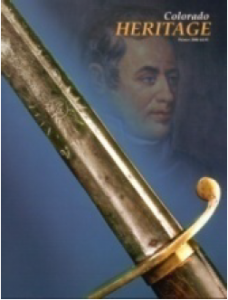 |
| Pikes Peak as seen from Garden of the Gods. Photo courtesy Colorado Tourism Office. |
Without a doubt, it’s Colorado’s most famous mountain. And while it’s neither the tallest mountain in Colorado nor the most difficult to scale, Pikes Peak is famous for its visibility from the plains, its use as a symbol of the 1859 Colorado Gold Rush, and for the legendary explorer for whom it is named.
Zebulon Montgomery Pike, a U.S. Army soldier, arrived in present-day Colorado in 1806 to explore the lands that were now a part of the United States as a result of the Louisiana Purchase. Pike and his men were assigned to search out the source of the Arkansas River. While on this expedition, Pike spotted what he described as a “small blue cloud” in the distance. This “cloud” turned out to be the peak that would be named in his honor. Pike and his men wintered in the area at what came to be known as Pike’s Stockade, and during the long winter Pike set out to explore the peak that had captured his interest. Perhaps due to the heavy snows, Pike never did climb his peak; fourteen years later, a member of Stephen Long’s Expedition named Edwin James became to be the first to climb it, so the mountain became known as James Peak for a time.* However, when settlers began pouring into Colorado in the 1850s in search of gold, the mountain was renamed for its early admirer and became a symbol of the Gold Rush. In fact, “Pike’s Peak or Bust” became the rallying cry for the gold seekers.
According to official rankings, Pikes Peak is Colorado’s 30th highest mountain, at 14,110 feet. Colorado has 53 “fourteeners.” The spelling of the name can be confusing. Since 1890 Pikes Peak has officially been spelled without the possessive apostrophe. The U.S. Board of Geographic Names has removed nearly all apostrophes from place names for uniformity and ease of signage. Colorado’s Longs Peak also lacks the apostrophe.
Pikes Peak is also a major tourist attraction. Visitors not only can hike up the mountain, but also have the option of driving up or taking the famous Pikes Peak Cog Railway. Pikes Peak and nearby mining towns also make up the Gold Belt Tour Scenic & Historic Byway.
In our library you can find many resources relating to the history, geology, and biology of Pikes Peak. Resources listed below without hyperlinks can be checked out in print.
 For biographical resources on Zebulon Pike, see the following:
For biographical resources on Zebulon Pike, see the following:
- “The Death of Zebulon Pike,” by Robert M. Warner, Colorado Magazine, April 1955.
- “Pike and His Peak,” by Judith Gamble, Colorado Heritage, Issue 3, 1989
- “Where is Zebulon Montgomery Pike Buried?” by Albert W. Thompson, Colorado Magazine, July 1936.
- “Zebulon Montgomery Pike,” by LeRoy R. Hafen, Colorado Magazine, July 1931.
- “Zebulon Pike in Southern Colorado: A Photo Travelogue,” by Michael Wren, Colorado Heritage, Winter 2006.
For resources on the Pikes Peak Gold Rush, see
- “Diary of a Pikes’ Peak Gold Seeker in 1860,” by Edward J. Lewis, Colorado Magazine, November 1937 and continued January 1938.
- “In the Pikes Peak Gold Rush of 1859,” by E. Dunsha Steele, Colorado Magazine, October 1952.
- “Letters of a Returned Pikes Peaker,” by J. S. Baker, Colorado Magazine, May 1947.
- “Pikes Peak Fifty-Niner: The Diary of E. A. Bowen,” edited by Duane Smith. Colorado Magazine, Fall 1970.
- “Pikes Peakward on the Smoky Hill Trail,” by Lee Whiteley, Colorado Heritage, Jan/Feb 2010.
- “Rush to the Rockies, 1859,” by Agnes Wright Spring, Colorado Magazine, April 1959.
To learn about the natural resources of Pikes Peak the surrounding area see
- Biological Survey of the Pikes Peak Area, Colorado Natural Heritage Program/Colorado State University, 1998.
- Sustaining Nature and Community in the Pikes Peak Region, Colorado Department of Transportation, 2007.
- Tourist Guide to Colorado Geology, Colorado Geological Survey, 2009.
For resources on Pike’s Stockade, see
- An Archaeological Inventory in the Pike’s Stockade Area, Conejos County, Colorado. Colorado Historical Society, 2007.
- “Historical Projects at Fort Garland and Pike’s Stockade,” by Edgar C. McMechan, Colorado Magazine, September 1946.
- “The Pike Stockade and its Purchase by the State of Colorado,” by Henry Dubbs, Colorado Magazine, January 1927.
- “Winter in Pike’s Stockade,” by Michael Wren, Colorado Heritage, Winter 2006.
For other historical information, see
- History of Colorado, by LeRoy R. Hafen, State Historical and Natural History Society, 1927.
- “The Naming of Pike’s Peak,” by Raymond Calhoun, Colorado Magazine, April 1954.
- “Through a Glass Sharply: Edwin James and the First Recorded Ascent of Pikes Peak, July 13-15, 1820,” by Phil Carson. Essays and Monographs in Colorado History, n. 14, 1994.
Additionally, mini-biographies of Zebulon Pike, Julia Archibald Holmes (first woman to summit Pikes Peak), and Daniel Cheesman Oakes (goldseeker and Pikes Peak guidebook author), are available from Colorado Virtual Library. Also be sure to check the Colorado Encyclopedia for articles.
*The Arapaho Indians called it Long Mountain, and Spanish explorers knew it as El Capitán.
- How to Spot the Differences Between Eagles and Hawks - August 16, 2021
- How Transportation Projects Help Tell the Story of Colorado’s Past - August 9, 2021
- Time Machine Tuesday: The Night the Castlewood Canyon Dam Gave Way - August 3, 2021
